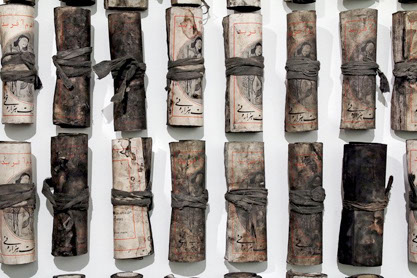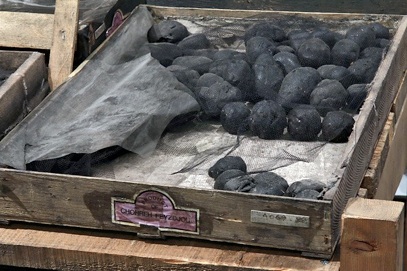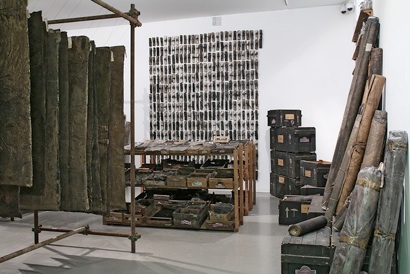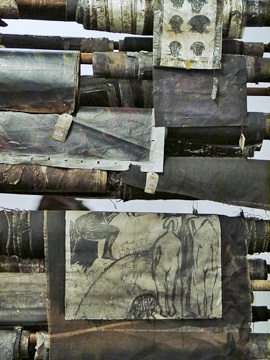

Chohreh Feyzdjou: l’Oeuvre au Noir
By Michel Dewilde
In the past months, the installation Untitled by the artist Chohreh Feyzdjou (1955 Teheran – 1996 Paris) was part of the exhibition Unedited History . Iran 1960 - 2014 , curated by Catherine David at the Musée d’Art Moderne de la Ville de Paris. It was great to see Feyzdjou’s work incorporated in a comprehensive Iranian group exhibition. Though her work has been a part of major international exhibitions, such as Okwui Enwezor’s Documenta 11, she was seldom included in an Iranian show.
I met Chohreh Feyzdjou in Paris in 1994, whilst preparing the exhibition Zij-Sporen [1]. She had left Iran in the seventies and was principally based in Paris. There she held her first major individual exhibition at the gallery Patricia Dorfmann in 1992, and was included in group exhibitions which I visited, such as "Invitations" at the Jeu de Paume in 1994. Subsequently she participated in several mainly European shows, till her premature death in 1996.
Chohreh Feyzdjou is best known for her large black installations. The work Untitled (1987-1994) shown at the Paris Museum epitomizes Feyzdjou’s artistic evolution from that period. The visitors are engulfed in a blackened environment, a landscape crisscrossed by a multitude of disparate objects. The environment reminds one of an abandoned store, dominated by rusty scaffolds with wrapped-up and overpainted canvases. Visible are the labels "Product of Chohreh Feyzdjou", which she stuck on all the objects. Hence her work was referred to as an ironic comment on consumerism, the process of reification, the questioning of the notion of authenticity etc. Feyzdjou’s art is further related to the world of the oriental bazaars and their display of goods. Finally, her work was tied to the figurations of the exile, the refugee, and the nomad. But she refuted these initial readings; I recollect her reaction in her Paris studio to the show Heart of Darkness (1994) that she was preparing at the Kröller-Müller Museum. She objected to being identified as an exile; she wanted to be seen as an individual, not representing a nation, culture or religion. Feyzdjou’s objection was an example of a growing post-identity viewpoint from non-Western artists who refused to be reduced to symbols of ethnic, cultural or geographical difference.
Another aspect that struck me in 1994, besides the overall blackness, was the overabundance of the corporeal in her work, a physicality that she violently altered. This feature was combined with an obsessive hunger for classification and registration. Chohreh Feyzdjou labelled and numbered each part of her installation. These installations were constructed out of older works and objects that she deformed and overpainted. She accumulated these traces of her past and transformed them into building blocks for new presentations. Compelling was her emphasis on remembrance and the legibility of her work. The black installations functioned as private archives, enclosing both Feyzdjou and the visitor. Crucial here was the way she reoriented the viewer’s reading of these remnants of the past. Because she hid or blackened her older artworks or objects, the viewer could see them only from the outside. They were thus experienced as surfaces or as a group of things, hardly distinguishable from each other, losing their original appearance or meaning. Feyzdjou created a distorted archive that we could enter, but hardly read: Absence is a key concept here.
Through the conservation and classification of her past, Chohreh Feyzdjou can be seen as a precursor of the recent archival tendency in art. Here I add some biographical considerations: I relate Feyzdjou’s fascination with ancient Egypt to her fatal illness. She knew she could die at any moment; she told me so when we met in Paris. From that perspective, her installations take on a different dimension: they become funeral shrines. Was Chohreh surrounding herself with the objects of her past, preparing, like a dying pharaoh, for the ultimate voyage?
Zij-Sporen
In 1993, I developed with a few artists the concept for the site-specific exhibition Zij-Sporen, located on board moving trains and in stations. [1] Indebted to writings such as Rosi Braidotti’s Nomadic Subjects, I thought it would be interesting to explore nomadic and non-fixed subject positions in a context that embodies forms of physical and mental movement. The transitory nature of the train and travelling seemed a challenging environment. My curatorial practice was orientated towards an analysis of the relations between the exhibition concept and its formal and spatial translation at the level of the locality and the presentation of artworks. Thanks to the Gynaika Foundation (Antwerp), the exhibition was realized in April 1996. Each of the selected artists chose a type of carriage or station and created a new work for that location. Every two days, the exhibition left for another city in Belgium, France or Holland. This continuous travelling reinforced one of the tenets of the project: the transient, incidental and unpredictable nature of movement and travel, aspects that interested Chohreh Feyzdjou above all.
She selected the sumptuous passenger car (model K1A) designed for the Belgian Railways during the interbellum by the architect Henry van de Velde. Feyzdjou mentioned the role trains played in the deportation of Jews during the Holocaust and referred specifically to the piles of shaven hair. In past reviews, her passenger car was wrongfully described as being used for the "deportation of Belgian Jews to Auschwitz". Probably Feyzdjou’s car was confused with another artwork of Zij-Sporen: the freight wagon selected by the English artist Helen Chadwick, a model that was massively used for the deportation. Chohreh Feyzdjou, on the other hand, was fascinated by the fact that her chosen first-class passenger car was used chiefly by high dignitaries. She wanted to infiltrate with her black oeuvre this exclusive, political world of the 1930s, where dignitaries travelled in a privileged environment, unfazed by or ignorant of the first deportations. She filled this lavishly finished car, made out of rare woods and exquisite fabrics, with tons of black hair at eye level. On the outside of the car she applied her "Product of ..." stickers… thus objectifying it as she did her older artworks. At the entrances of the carriage, she piled crates filled with black hair. Daily the inspectors had to unload them, stack them onto the platform and open some randomly.
The visit of her carriage and the unloading of the crates embodied the act of remembrance so important in her work. Feyzdjou made it clear that the visitors could experience this work only from the outside, looking at it through the windows and the inside doors of the car. Like a grave, this car could not be entered, could not be desecrated. Unfortunately, Chohreh Feyzdjou died before the exhibition was completed. [2] I believe that works such as the Zij-Sporen installation marked a new phase in her oeuvre. She seemed to move beyond her previous works, mixing site-specificity with an inclination towards the performative.
This emphasis on performance is all the more striking when we link it to the recent installation of the sarcophagus-sculpture on top of Chohreh Feyzdjou’s Parisian grave, created by the Iranian artist Barbad Golshiri. As part of the Unedited History. Iran 1960-2014 exhibition, Golshiri conceived Concession éphémère, a wax sarcophagus for Feyzdjou’s unadorned grave. Inside the casket is some black hair that was recovered after the dismantling of the installation of the Zij-Sporen exhibition in May 1996. Thus, Golshiri returned a fragment of Feyzdjou’s famous black hair, her lost memory, to the grave of the pharaoh.
Notes:
1.Zij-Sporen was a site-specific exhibition held on board passenger trains and in train stations between 4 April 1996 and 14 May 1996 in Belgium with stops in France and the Netherlands. Artists: Marina Abramovic, Helen Chadwick, Berlinde De Bruyckere, Chohreh Feyzdjou, Marie-Jo Lafontaine, Hale Tenger etc.
2.During preparations for the exhibition, Helen Chadwick suddenly died, as well. As was the case with Chohreh Feyzdjou, the Zij-Sporen exhibition was her last project.
Michel Dewilde : Belgian art historian and curator. He curated exhibitions for the MSK & SMAK Museums (Ghent), Gynaika (Antwerp), CC Bruges, and works freelance. He is currently one of the curators of the Bruges Triennial for Contemporary Art and Architecture.
from Nafas
work from artist Chohreh Feyzdjou



started 1 MAY 2010 email : info@ila-magazine.com
design: gitta pardoel logo: modhir ahmed © ila-magazine